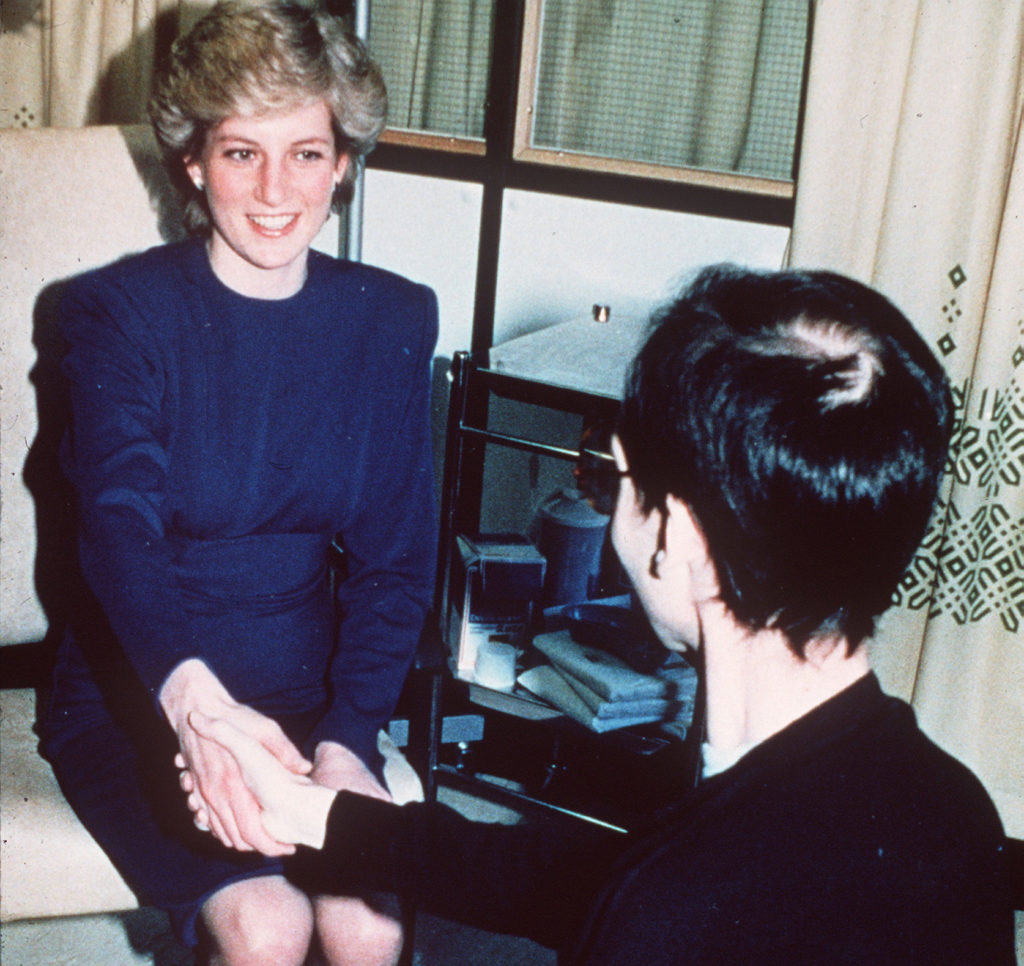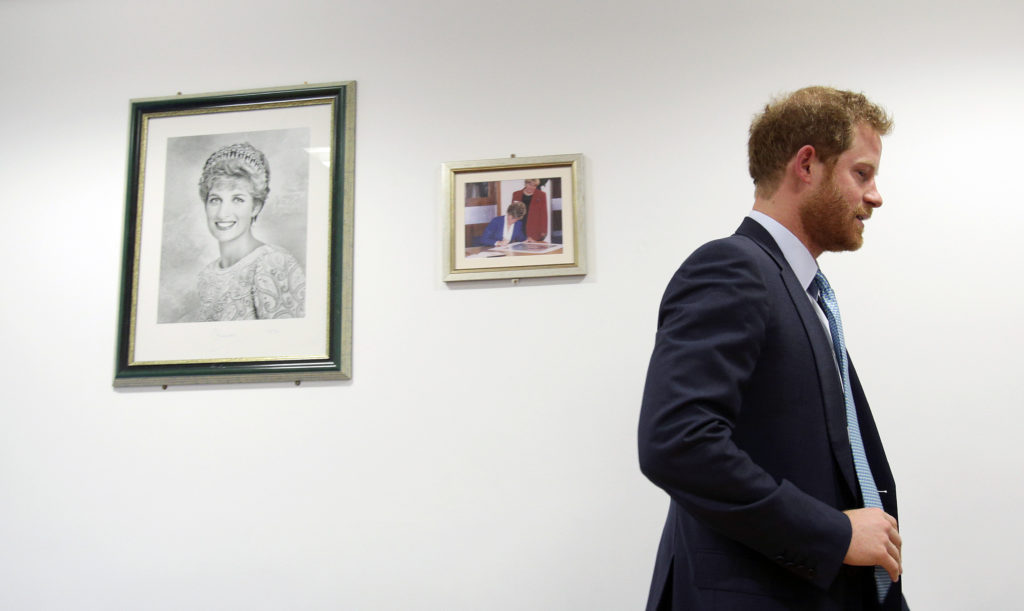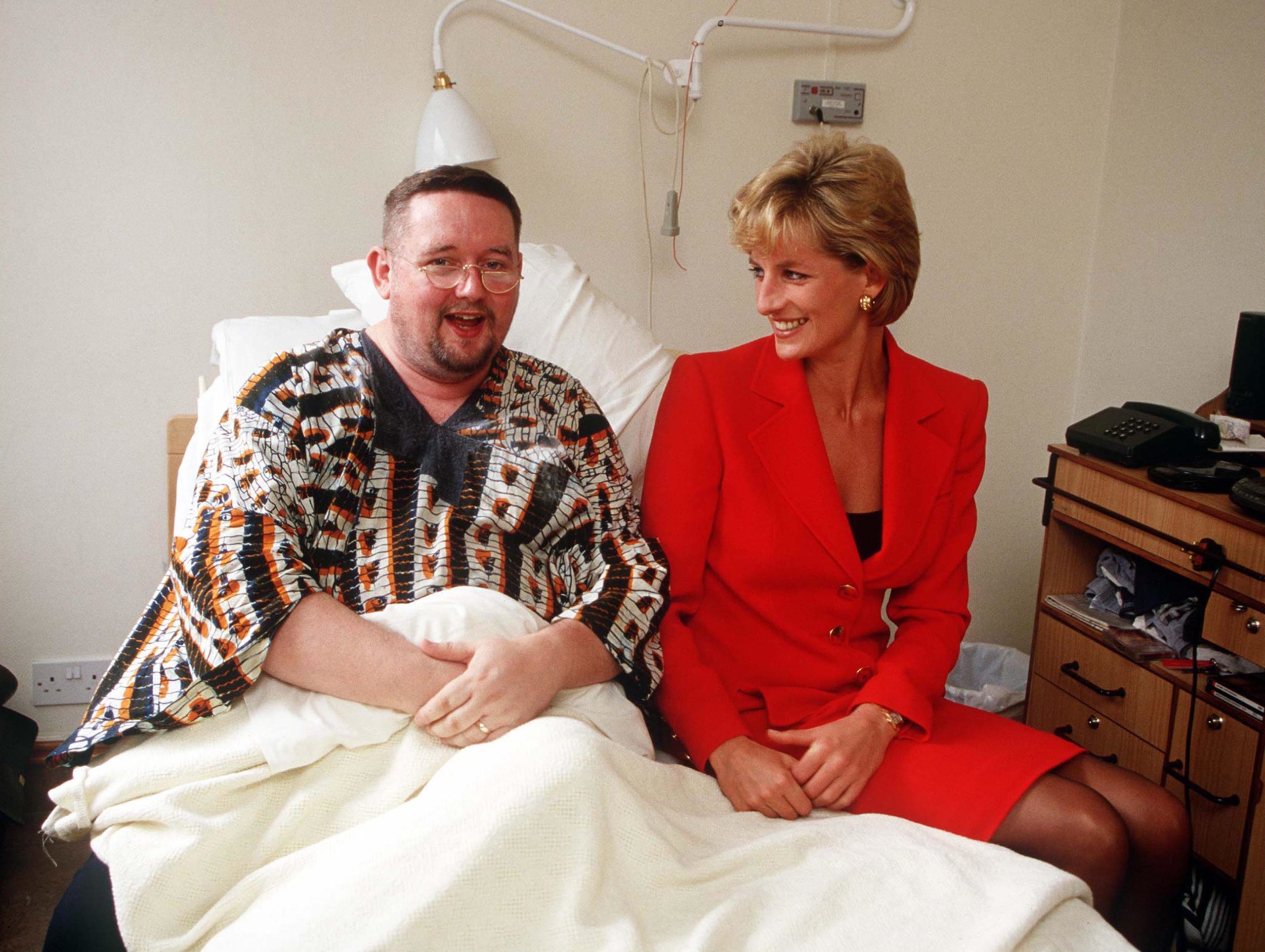Princess Diana visiting a patient at the London Lighthouse, a centre for people affected by HIV and AIDS, in 1996. (Jayne Fincher/Getty Images)
23 years ago today, Diana, Princess of Wales, was killed.
A photograph of a dented car shuddered throughout the news wires that night, leaving billions reeling and in a death that drew out a complicated mix of anger and grief.
In the sense of loss that followed, a single moment of Diana would come to be left for the AIDS patients at London Middlesex Hospital, after her tragic death on August 31, 1997.
For many of them, fear and dread had come to be expected from loved ones visiting them, if they came at all, or even the healthcare workers supporting them.
Indeed, a lack of understanding, as well as misinformation around a wily and devastating virus, had led to the deaths of countless LGBT+ people. Many feared that HIV could be passed from person to person by touch.
But seeing the outstretched, bare hand of a smiling Diana in 1987 was a moment that gave them, and many of the thousands living with HIV, hope.
‘I don’t doubt that had she lived she would have been a powerful ally in combatting HIV stigma.’
None of the 12 patients at Britain’s first purpose-built HIV/AIDS unit wanted to see her. They feared what becoming the subject of a press vastly hostile to people living with HIV would make of them.
Eventually one man, who was not far from death, agreed to meet Diana.
In front of the world’s media, Diana shook the hand of a man diagnosed with the illness.

A simple, bold act that came to capture how Diana would be remembered even now, 23 years after her death, as the wild card of a monarchy that rejected her, and someone as dynamic as they were glamorous.
Diana declared to the press pen jockeying around her: “HIV does not make people dangerous to know.
“So you can shake their hand and give them a hug, heaven knows they need it.”
She was remembered by many top HIV groups and LGBT+ leaders as a pioneer who broke ranks to be there for one of the most vulnerable and marginalised groups of society.
Today marks 23 years since the world lost Princess Diana.
We remember the inspiring and groundbreaking impact she had on the lives of people living with #HIV and #AIDS.
She saw the people behind the stigma and discrimination and helped change public perceptions. pic.twitter.com/Z3K5bVxM3Z
— National AIDS Trust (@NAT_AIDS_Trust) August 31, 2020
Matthew Hodson, executive director of NAM aidsmap, told PinkNews how, as a child of the eighties, Diana was an “unavoidable” part of his life.
“She was there every day, laughing or crying on the front pages of the newspapers,” he said.
“Shaking the hand of someone with AIDS, at a time when there was no effective treatment, may seem tiny now but at the time it was pivotal.
“I don’t doubt that had she lived she would have been a powerful ally in combatting HIV stigma.
“Nobody expected her story to end so abruptly. I was surprised by my grief. I joined the crowds between Kensington and Buckingham Palaces to watch the funeral cortege go past.
“The horses drawing the coffin kicked up dust, which caught the sunlight. The mourners surrounding me on that section of the route seemed to be mainly Black men and women, people with visible disabilities, and gay men and lesbians.
Diana, with all her privileges of birth, spoke of feeling like an outsider. I think many who felt marginalised by society related to her and were hit particularly hard by her death.
“It still makes me sad.”
Fraser Wilson from Terrence Higgins Trust, a sexual health charity, told PinkNews: “With handshakes and hugs, Princess Diana helped change perceptions of HIV and quieten some of the hysteria raging during the early days of the epidemic.
“Through her actions she made it clear you couldn’t contract HIV from touching or close contact. The impact of Princess Diana putting the spotlight which followed her on people with HIV should not be underestimated or forgotten.
“She is sorely missed. Princess Diana’s work is now being honoured and built upon by her son Prince Harry.
“We’ve come a long way since the 1980s when it comes to HIV stigma, but there’s still a long way to go.”
Princess Diana: A magnetic royal whose kind legacy sparked her sons to pick-up her mantle.
The photographs of Diana visiting HIV wards across Britain became synonymous with her legacy for kindness, as she went onto become an official patron for the National AIDs Trust, a charity founded to debunk many of the toxic myths clouding the illness.
At a 1993 speech Diana delivered at one of the organisation’s events, she reflected on the ways in which HIV whittles away at the lives of mothers and their children – further dispelling a myth that HIV was a problem only for queer men.
“For those mothers and children already living under the shadow of AIDS,” she said, “we need to help them back into the light, to reassure them and support their needs.
“And maybe we will learn from them how to live our own lives more fully, for however long it may be.”
As much as negative attitudes continue to persist and curdle towards HIV, the ways in which Diana offered the royals, long enamoured by old conventions, a way to modernise has been applauded..
Both her sons have gone onto become their own lodestars in the fight against the snarling stigmas of HIV/AIDs, embodying a more youthful generation of royals.
In 2015, Prince Harry, Duke of Sussex, donned a red AIDS ribbon on Monday while he paid a visit to Mildmay, a charitable HIV hospital located in East London.

Meeting with patients and staffers, he took a HIV test to show how easy it is. Another small act that carries immeasurable weight.
“When my mother held the hand of a man dying of AIDS,” the prince said, “no one would have imagined that just over a quarter of a century later treatment would exist that could see HIV-positive people live full, healthy, loving lives.”
He added: “If she were still here today, she would probably get tested every month, just to prove a point.”
Meanwhile, Prince William, Duke of Cambridge, appeared on the cover of British gay magazine Attitude to condemn homophobic bullying.
Diana will, for years to come, continue to be lauded for her philanthropy and warmth. It can be difficult to boil down 36 years of a person’s life, but one quote comes close.
“Nothing brings me more happiness than trying to help the most vulnerable people in society,” Diana said in a 1995 interview.
“It is a goal and an essential part of my life, a kind of destiny.”
